Best Practices for Accessible Tables and Graphs in eBooks

Tables and graphs are an inherent part of many publications, such as research papers, textbooks or reports. They contain condensed information and enable readers to gather and analyse data quickly. However, they are a challenge for blind and visually impaired individuals – unless they are prepared correctly. In this article, we will explain why tables and graphs are so important and tell you how to make them accessible for screen reader users.
The Role of Tables and Graphs
Tables and graphs are key to presenting, analysing and comparing data. Blind individuals use these tools too, for example:
- Education
- Professional work
- Everyday life
The inability to access these resources means that blind individuals have fewer opportunities to learn or make conscious decisions.
However, better structured data would be beneficial for other groups of users as well:
- People with dyslexia – clearly marked headings and logical table structure make it easier to understand the data an ebook contains.
- People who use assistive technologies e.g. enlarging tools – people who have poor eyesight, and a growing number of people whose eyesight is worsening, who use enlarging tools will be able to gather information quicker and more effectively if it is marked correctly.
- People with cognitive distortions – correctly described graphs and tables will help them to think and analyze content more effectively
- People who use mobile devices (a large group of readers) – responsive and accessible tablesmake it easier to browse data on small screens, as it is no longer necessary to browse horizontally.
Table Structure
In order to make a table accessible, you have to mark it correctly in HTML code. In order to do so, you need to use correct markers and attributes which will help screen readers analyse a table’s structure.
It is important to remember to:
- Use the <table> marker to mark a table.
- Mark column and row headings using <th>, not <td>.
- Use the scope attribute to indicate whether a heading refers to a row (row) or a column <col>.
Example of an accessible table:
<table>
<tr>
<th>Product</th>
<th>Price</th>
<th>Availability</th>
</tr>
<tr>
<td>Apples</td>
<td>5 zł/kg</td>
<td>Available</td>
</tr>
<tr>
<td>Oranges</td>
<td>6 zł/kg</td>
<td>Unavailable</td>
</tr>
</table>
If a table’s structure permits it, it is good to use <thead> and <tbody> markers, which facilitate separating headings from table content.
Example of an accessible table:
<table>
<thead>
<tr>
<th scope="col">Product</th>
<th scope="col">Price</th>
<th scope="col">Availability</th>
</tr>
</thead>
<tbody>
<tr>
<td>Apples</td>
<td>5 zł/kg</td>
<td>Available</td>
</tr>
<tr>
<td>Oranges</td>
<td>6 zł/kg</td>
<td>Unavailable</td>
</tr>
</tbody>
</table>
Depending on how complicated the table is you may not need to use thead and tbody. It is most important to keep the structure clear and logical, which makes data easier to navigate.
Alternative Text and Detailed Descripions
People who use screen readers will also need:
- Alternative text (alt) – it should state what type of graph it is and what it portrays.
- A longer description (longdesc or included in text content) – a detailed summary of data, trends and conclusions.
Graph Description - Example:
“A line chart showing temperature changes in Warsaw throughout the year. The lowest temperature was -5°C in January, and the highest – 30°C in July. In spring and autumn temperatures are between 10-20°C.
This way, a blind individuals can access information, as it is not necessary to interpret a picture.
Tables Accessible for Everyone
As we have already mentioned, in order to make tables and graphs accessible for everyone, they have to be correctly marked and accompanied by text descriptions. Thanks to correct HTML markers, attributes and descriptions, blind individuals are able to use ebooks and other digital publications.
The examples described in this article highlight what we often say – that digital availability is not only imposed by law, it also helps you create ebooks more accessible and useful for all users.
Sources:
https://docs.uci.pb.edu.pl/dostepnosc/dostepnosc.html
https://utilitia.pl/baza-wiedzy/tworzenie-dostepnych-dokumentow-elektronicznych-w-microsoft-excel/
https://bon.uew.pl/wp-content/uploads/sites/38/2024/07/04.-WCAG-Tabele-wykresy-i-wzory-matematyczne.pdf
The article was created in close collaboration between the Polish Foundation for the Blind and Visually Impaired "Trakt” and Have a Book.
Translated by Aleksandra Kallas
Monika Zarczuk-Engelsma
Monika Zarczuk-Engelsma was born in the Lublin region, and her early years were connected to a school for the blind in Kraków. She graduated from the Academy of Podlasie with a degree in Polish Philology, and then continued her education at the University of Gdańsk, obtaining a diploma in postgraduate studies in Partnership Marketing and Public Relations. This closely aligned with the position she was entrusted with at one of the non-governmental organizations in the Tricity area.
As part of expanding her professional experience, Monika participated in projects teaching computer skills to blind individuals, conducted training on volunteerism, tried her hand at copywriting, took part in the European Union’s European Voluntary Service project, and also secured an internship at the European Economic and Social Committee. Monika is now the office manager of the Polish Foundation for the Blind and Visually Impaired "Trakt.”
In her daily life, she uses Braille but also readily takes advantage of modern technology, such as an iPhone equipped with VoiceOver, a screen-reading laptop, a talking thermometer, and a bathroom scale that announces measurements in a clear female voice. Thanks to these tools, Monika achieves a high level of independence and is able to live the way she enjoys—actively and engagingly, meeting new people, working, reading books, and pursuing hobbies such as playing chess, board and card games, cooking, and traveling (she has already visited over 30 countries).
Currently, she is also raising two wonderful children, taking care of two already adult cats, and running her dream home with a garden.